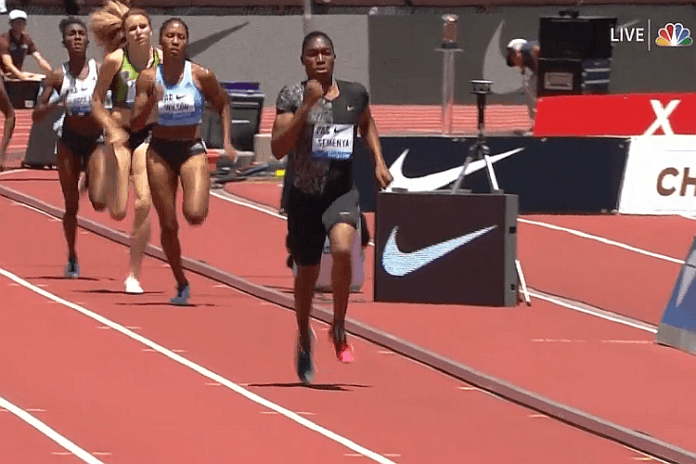The roller-coaster ride of an appeal by South Africa’s double Olympic 800 m champ Caster Semenya against the IAAF’s female eligibility regulations in specific events took another dive on Tuesday, as the Swiss Federal Tribunal reversed its stance and reinstated the IAAF’s rule after suspending it last month.
The court order was not made immediately available and the only reports of the decision came from statements from Semenya’s representatives. According to The Guardian, “Dorothee Schramm, the lawyer leading her appeal, said: ‘The judge’s procedural decision has no impact on the appeal itself. We will continue to pursue Caster’s appeal and fight for her fundamental human rights. A race is always decided at the finish line.’”
Schramm’s point is important. The case itself has apparently not been decided, but the IAAF’s regulations – which were upheld by the Court of Arbitration for Sport – are now back in place, meaning that athletes competing in events from 400 m to the mile in the women’s division must meet the requirements of testosterone levels of less than 5 nmol/L for at least six months.
If the court’s final decision does not change the IAAF’s rules, or comes after the World Championships in Doha (QAT) that start 28 September, only athletes who meet these specifications can compete.
That would eliminate Semenya, the 2019 world leader in the 800 m at 1:54.98, as well as Burundi’s Francine Niyonsaba, the Rio silver medalist and 2017 Worlds silver medalist behind Semenya, who has same “differences in sex development” regulated by the IAAF’s rule.
It also makes American Ajee Wilson the gold-medal favorite; she ranks second on the 2019 year list at 1:57.72 from the USATF Nationals in Des Moines last weekend; Niyonsaba is third at 1:57.75.
The court is expected to release the decision on Wednesday.
¶
Dalilah Muhammad’s world record in the 400 m hurdles in Des Moines was a shock, even to her, but it wasn’t as if she didn’t see it coming.
She said afterwards, “I’ve been kind of hitting that time at practice, consistently, and my coach [Lawrence Johnson] is just like… he said there’s no way you can’t do it, you just gotta execute off that last 40… and his words – to drop your arms – kind of hit me that last 40 and I was just trying to hold on.
“I was hoping for it this whole weekend. Funny enough, I got a little injured like two weeks ago. I had a crazy fall and so we’ve kind of been shutting down. It’s just one of those things that you’re just hoping for the best. I just trusted in what we had been working on at this point.
“I saw the time and I knew. I was shocked, but I knew.”
¶
There were lots of stories from the USATF Nationals, but one of the best got buried with Muhammad’s world record, Allyson Felix in the 400 m and great sprinting from Christian Coleman and Noah Lyles. That would be the fourth-place finisher in the women’s 3,000 m Steeplechase, Allie Ostrander.
The three-time NCAA Steeple champ from Boise State ran 9:37.73 – a lifetime best – to win the NCAA title in Austin, Texas, then lowered her PR to 9:31.44 at the Prefontaine meet at Stanford and then made the U.S. Worlds team, running 9:38.52 in Des Moines.
“Wearing the U.S. uniform will be something special,” she said afterwards. “It is one of the hardest teams to make and I will take the Worlds very seriously and try to do my best. I’m happy to get the opportunity and thankful to be on Team USA.
“The plan today was if they (Emma Coburn, Courtney Frerichs and Colleen Quigley, who went 1-2-3) went out I wanted to try to go with them as long as I could and still have a little left in the tank.”
“I’m going to take some down time since I’ve been racing since December.
Interestingly, she also said, “I don’t want to stay a steeplechaser. I want to give the 10k another try as well as the 5,000 and 1,500. I want to explore other events.”
According to Tilastopaja.org, the USATF race was her 20th of the season,, beginning with an indoor 5,000 m back on 1 December 2018. She’s earned some rest, but at 23rd on the world list for the Steeple, she has a modest shot at making the final in Doha with another PR.
At 22, she has a lot of running ahead of her.
¶
The U.S. wasn’t the only country with national championships taking place. After Russia’s Mikhail Akimenko equaled the world lead in the high jump to 2.33 m (7-7 3/4) on the 26th (Friday) at the Russian nationals in Cheboksary, Italy’s 21-year-old Stefano Sottile jumped the same height at the Italian nationals in Bressanone (ITA).
Akimenko does not appear on the lists of Approved Neutral Athletes from the IAAF and would not, unless something changes, be able to compete in Doha. The other world leader, Russia’s Ilya Ivanyuk, is cleared to compete internationally.
¶
The 2012 Olympic silver medalist in the 1,500 m, Leo Manzano, announced his retirement at age 34. He was a star at Texas, winning two indoor and two outdoor 1,500 m/mile titles between 2005-08.
He had a fearsome finish and ended with outstanding lifetime bests of 1:44.56 (2010), 3:30.98 (2014) and 3:50.64 for the mile (2010). He retires ranked no. 6 on the all-time U.S. 1,500 m list.




























